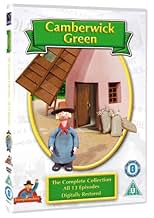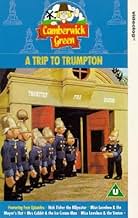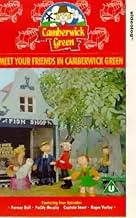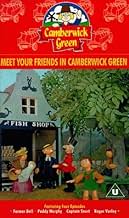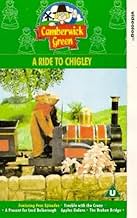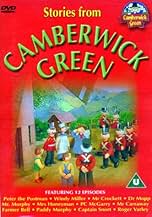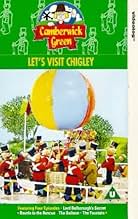Adicionar um enredo no seu idiomaIconic British children's animated series set in the fictional, picturesque village of the title. Each episode opens with a character emerging from a music box and they will be the central c... Ler tudoIconic British children's animated series set in the fictional, picturesque village of the title. Each episode opens with a character emerging from a music box and they will be the central character of the forthcoming story.Iconic British children's animated series set in the fictional, picturesque village of the title. Each episode opens with a character emerging from a music box and they will be the central character of the forthcoming story.
Explorar episódios
Avaliações em destaque
I always get this one mixed up with "Chigley", so my apologies if I end up rambling on about two different programmes.
Anyway, both programmes were, I believe, originally part of the BBC's umbrella "Watch With Mother" title, a series that, undoubtedly, shaped a nation. I clearly remember worrying my grandmother to check the newspaper as soon as it arrived each weekday morning to see which character was featured that day. Other programmes in the series included "Andy Pandy" (who, even at the tender age of five, I considered to be a right wimp), "Bill and Ben" (Kings of the "Watch with Mother" gang), and Hector's House (a later addition to the gang, I believe, which never possessed the same charisma as its predecessors).
"Camberwick Green" (and/or "Chigley") featured a host of fascinating characters: the trusty firemen (no demands for a 40% pay rise in the Camberwick Green division - a slippery pole and a shiny fire engine, and they were happy firemen); Windy Miller, the rustic windmill operator, who always managed to time his walk so that he passed between the rotating blades of the windmill without having to run or pause in order to avoid injury; the dear old lady who sold flowers; the fat mayor; the town clerk with the glasses. No five year old could help but be gripped by the dramatic twists and turns in their lives.
"Camberwick Green" and "Chigley" were invaluable in instilling a moral backbone into the tots of the 60s, thereby shaping today's movers and shakers in the UK. "Bananas in Pyjamas" and "Teletubbies"? Pah! and Piffle! - what hope for a nation whose future leaders have been raised on such uninspiring rot?
Anyway, both programmes were, I believe, originally part of the BBC's umbrella "Watch With Mother" title, a series that, undoubtedly, shaped a nation. I clearly remember worrying my grandmother to check the newspaper as soon as it arrived each weekday morning to see which character was featured that day. Other programmes in the series included "Andy Pandy" (who, even at the tender age of five, I considered to be a right wimp), "Bill and Ben" (Kings of the "Watch with Mother" gang), and Hector's House (a later addition to the gang, I believe, which never possessed the same charisma as its predecessors).
"Camberwick Green" (and/or "Chigley") featured a host of fascinating characters: the trusty firemen (no demands for a 40% pay rise in the Camberwick Green division - a slippery pole and a shiny fire engine, and they were happy firemen); Windy Miller, the rustic windmill operator, who always managed to time his walk so that he passed between the rotating blades of the windmill without having to run or pause in order to avoid injury; the dear old lady who sold flowers; the fat mayor; the town clerk with the glasses. No five year old could help but be gripped by the dramatic twists and turns in their lives.
"Camberwick Green" and "Chigley" were invaluable in instilling a moral backbone into the tots of the 60s, thereby shaping today's movers and shakers in the UK. "Bananas in Pyjamas" and "Teletubbies"? Pah! and Piffle! - what hope for a nation whose future leaders have been raised on such uninspiring rot?
If you saw this as a kid, as soon as you hear the chiming mandolin notes of the opening theme you're mesmerised. This was the model for a thousand kids' shows, but what it has that most of them lack is that quality of calm. It really strikes me, seeing it again after so many years, how deeply it feels rooted in the past. Not the 1960s; with its farm smocks, mutton-chop sidies, penny farthings, windmills and crank-started motor cars, it feels more like the Edwardian era or even earlier. It's all about stability, continuity, and scepticism about change - several eps revolve around some art of the modern 'grid' going wrong, and the villagers having to rely on the old ways as maintained by Windy Miller. This is very much the opposite to the message of kids' programmes today; in fact these seem to be values which have now largely died out, and the battle for modernity (even in the mind) won.
So this is now, even more than at the time, a haven for those of us who feel bruised by the avalanche of improvement coming down on our heads. It's nothing short of amazing that it was created by a total of only seven people - today, with all the improvements, it would take at least a hundred. The stories are nothing much - maybe that's the attraction - but what really makes it is that fantastic acoustic music by Freddie Philipps. He deserves an MBE for it, at least - it just takes you away from yourself and into a better place: Camberwick Green. I suppose he was also responsible for the sound of Windy Miller's sails going round which, once you've heard it, it with you for life.
So this is now, even more than at the time, a haven for those of us who feel bruised by the avalanche of improvement coming down on our heads. It's nothing short of amazing that it was created by a total of only seven people - today, with all the improvements, it would take at least a hundred. The stories are nothing much - maybe that's the attraction - but what really makes it is that fantastic acoustic music by Freddie Philipps. He deserves an MBE for it, at least - it just takes you away from yourself and into a better place: Camberwick Green. I suppose he was also responsible for the sound of Windy Miller's sails going round which, once you've heard it, it with you for life.
...wound up and ready to play. But, this box can hide a secret inside it. Can you guess what is in it today?
So began all the episodes of 'Camberwick Green', a peaceful, sleepy village in Trumptonshire, the first of the Gordon Murray puppet series. One would be on the edge of one's seat, trying to guess which character would come turning up out of the music box, to the haunting, high-pitched tune.
It might have been Peter Hazel the Postman, Jonathan Bell the farmer, Mickey Murphy the baker, Mr. Carraway the fishmonger or - best of all - Windy Miller. Each episode centred on this particular character, the story and events developing around him or her. The viewer tended to follow the character through a day, seeing where he or she lived and worked, and trying to join in with his or her own, catchy little song.
For example : "Mr. Murphy is a master baker, pudding, pie and pastry maker, biscuits, buns and birthday cakes; everything is masterly that Murphy makes!"
The episode ended with the character's return inside the musical box, with narrator Brian Cant wishing them, "Good-bye!"
The strengths of the series were its good plots, repeated sequences (so important for children, like the musical box) and its rounded, memorable characters. Who can forget nosey gossip Mrs. Honeyman (we never saw her chemist husband - with a wife like her, he probably never spoke), Mrs. Dingle in the Post Office with her yappy dog Packet, P.C. McGarry Number 452, wealthy Dr. Mopp with his grand house and car and - above all - Windy Miller, with his penchant for home-brewed cider? There was room enough in Camberwick Green for Pippin Fort, where lived Captain Snort, Sergeant Major Grout and the six Privates Armitage, Featherby, Hopwood, Higgins, Lumley and Meek. ("Driving along in an army truck, in a humpity, bumpity army truck...").
Such was their popularity that ornamental figures of many of the characters in 'Camberwick Green', 'Trumpton' and 'Chigley' have been available for sale in the last few years. Videos of some episodes have been also produced. It is a compliment to the programme that I can remember so much about it, so many years later.
My brother and I loved 'Camberwick Green' and its offshoots. In the early 1970s, we were fortunate to attend an exhibition of life-size puppets of the series, in Clacton in Essex, and we still have the photographs! The series deserves to be repeated; it was a classic.
So began all the episodes of 'Camberwick Green', a peaceful, sleepy village in Trumptonshire, the first of the Gordon Murray puppet series. One would be on the edge of one's seat, trying to guess which character would come turning up out of the music box, to the haunting, high-pitched tune.
It might have been Peter Hazel the Postman, Jonathan Bell the farmer, Mickey Murphy the baker, Mr. Carraway the fishmonger or - best of all - Windy Miller. Each episode centred on this particular character, the story and events developing around him or her. The viewer tended to follow the character through a day, seeing where he or she lived and worked, and trying to join in with his or her own, catchy little song.
For example : "Mr. Murphy is a master baker, pudding, pie and pastry maker, biscuits, buns and birthday cakes; everything is masterly that Murphy makes!"
The episode ended with the character's return inside the musical box, with narrator Brian Cant wishing them, "Good-bye!"
The strengths of the series were its good plots, repeated sequences (so important for children, like the musical box) and its rounded, memorable characters. Who can forget nosey gossip Mrs. Honeyman (we never saw her chemist husband - with a wife like her, he probably never spoke), Mrs. Dingle in the Post Office with her yappy dog Packet, P.C. McGarry Number 452, wealthy Dr. Mopp with his grand house and car and - above all - Windy Miller, with his penchant for home-brewed cider? There was room enough in Camberwick Green for Pippin Fort, where lived Captain Snort, Sergeant Major Grout and the six Privates Armitage, Featherby, Hopwood, Higgins, Lumley and Meek. ("Driving along in an army truck, in a humpity, bumpity army truck...").
Such was their popularity that ornamental figures of many of the characters in 'Camberwick Green', 'Trumpton' and 'Chigley' have been available for sale in the last few years. Videos of some episodes have been also produced. It is a compliment to the programme that I can remember so much about it, so many years later.
My brother and I loved 'Camberwick Green' and its offshoots. In the early 1970s, we were fortunate to attend an exhibition of life-size puppets of the series, in Clacton in Essex, and we still have the photographs! The series deserves to be repeated; it was a classic.
I remember when I was young and watching this series on television, and loving its simplicity. Now I'm older I have recently watched it on DVD and its just as excellent. It stands the test of time and have since shown it to my nephews, which they love. I whole heartily recommend this series, along with Trumpton and Chigely for young and old alike. It brings back nostalgic smiles and is such a truly well crafted production. 10 out of 10 for a simply brilliant collection to be worthy in anyones DVD collection. The series creator Gordon Murray has produced and created a true masterpiece. The bright colours and ingenious animations instantly will appeal to kids (my nephews are 3 and are glued to the TV when I put in on). The series narrator, Brian Cant does all the voices with enthusiasm and gusto to make the various characters really come alive and keep the small stories interesting. Each of the 3 series is around 13 episodes long and tells short 'tales' from the point-of-view of different people, yet all centre around the feeling of 'community' and 'pulling togeather'. The Music is also very nostalgic and complements the tone of the series nicely and each episode contains a 'charming' little song.
'Camberwick Green' is another one of those shows watched regularly as a kid but forgotten about for a while during teenagehood. Reliving all the fond memories over-time as a young adult re-watching various forgotten about family shows, many of them still hold up incredibly well and manage to be even better today. More so than not. 'Camberwick Green' was one of those shows that was quite unique at the time in terms of target audience appeal and its structure, which were always part of its charm.
It is still a wonderful show today and holds up beautifully without being too old-fashioned or too stuck in the time. Really love how it appeals to children and knows and embrace their viewing habits, as well as the way it focused on its characters. It is not easy making people living what sounds to some like fairly mundane lives fascinating and even educational, but 'Camberwick Green' did that wonderfully and is one of the very few shows to do this and to this well an extent.
Everything is great here in 'Camberwick Green'. The visuals are colourful and beautifully quaint, also quite advanced back then and one can still see how much effort was put into it. The backgrounds are especially well rendered and there is nothing stilted about the way the characters look.
The music is easy on the ear and is never overused or bombastic. The Baroque minuet theme tune is a stroke of genius. Absolutely loved the use of the beautiful looking music box, 'Camberwick Green' was one of the few masters to repeat elements and ideas and do it in a way that never became tired. The portrayal of the village was charming and fascinated and the social attitudes were interesting to note and didn't come over as too of the time.
Furthermore, the writing has a good deal of charm. It is very easy for younger audiences to understand, but does so without resorting to juvenile or dumb humour or using over complex terminology. Older audiences shouldn't find it a problem either, and find plenty to be amused by and be charmed by its simplicity. The stories are full of quaint charm and wisely keep things simple, while the pacing is deliberate it doesn't feel dull. Loved that they centered primarily around each characters.
And there are some memorable and beautifully varied characters here, my favourite being Windy Miller. Brian Cant's voice work is enthusiastic and versatile with no signs of over-compensating.
Overall, a classic. 10/10.
It is still a wonderful show today and holds up beautifully without being too old-fashioned or too stuck in the time. Really love how it appeals to children and knows and embrace their viewing habits, as well as the way it focused on its characters. It is not easy making people living what sounds to some like fairly mundane lives fascinating and even educational, but 'Camberwick Green' did that wonderfully and is one of the very few shows to do this and to this well an extent.
Everything is great here in 'Camberwick Green'. The visuals are colourful and beautifully quaint, also quite advanced back then and one can still see how much effort was put into it. The backgrounds are especially well rendered and there is nothing stilted about the way the characters look.
The music is easy on the ear and is never overused or bombastic. The Baroque minuet theme tune is a stroke of genius. Absolutely loved the use of the beautiful looking music box, 'Camberwick Green' was one of the few masters to repeat elements and ideas and do it in a way that never became tired. The portrayal of the village was charming and fascinated and the social attitudes were interesting to note and didn't come over as too of the time.
Furthermore, the writing has a good deal of charm. It is very easy for younger audiences to understand, but does so without resorting to juvenile or dumb humour or using over complex terminology. Older audiences shouldn't find it a problem either, and find plenty to be amused by and be charmed by its simplicity. The stories are full of quaint charm and wisely keep things simple, while the pacing is deliberate it doesn't feel dull. Loved that they centered primarily around each characters.
And there are some memorable and beautifully varied characters here, my favourite being Windy Miller. Brian Cant's voice work is enthusiastic and versatile with no signs of over-compensating.
Overall, a classic. 10/10.
Você sabia?
- CuriosidadesThe first children's show to be transmitted in colour by the BBC.
- ConexõesEdited into BBC Future Generations (1998)
Principais escolhas
Faça login para avaliar e ver a lista de recomendações personalizadas
Detalhes
- Data de lançamento
- País de origem
- Central de atendimento oficial
- Idioma
- Locações de filme
- Empresas de produção
- Consulte mais créditos da empresa na IMDbPro
Contribua para esta página
Sugerir uma alteração ou adicionar conteúdo ausente


